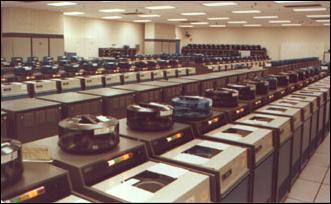In the mid- to late 1970s, I worked at Dun & Bradstreet's "National Business Information Center" in suburban New Jersey. This was the site where every D&B report was stored, printed, and dropped in the mail.
There were about a dozen of us twenty-somethings in the System Support Group writing a custom operating system to do this job. It was one of the best educations anyone could get. Typically, you can only do OS development at a computer company; doing this at D&B was a unique opportunity. Since nothing out there could fulfill D&B's database, report formatting/printing, and communications requirements, we wrote it all from scratch in assembly language. We were young. We were hot. (A footnote on that OS. It was derived from ICS-500, a message-switching system developed by Informatics Inc. My first full-time software job was at Informatics from 1973 to 1975. When I got laid off, I had the exact skill set D&B needed.)
Pack Me Up
The photo below was taken about 1977. The main database occupied about 110 of these 90MB (yes, megabyte) disk packs. The drives were made by Control Data Corporation and OEM'ed to Xerox Corp. Our site ran two Xerox Sigma-5 and five Sigma-9 computers at the time.) Each disk drive in this photo is about the size of a washing machine, and fewer than half are shown. (Biggest laundromat you ever saw!)
The total database size was about 10GB, quite large for its day. Nowadays, you can fit that inside an iPhone!
The database was so large that making a backup (or an update-merge) taxed the limits of the mainframe computer. You could only run 15 disk controllers (each the size of a refrigerator), and each of those could only handle 16 drives. That meant 240 drives were the absolute maximum you could run at once. Making a duplicate of the entire database required 220 drives, plus a couple for the operating system and software.
Just loading the 220 disk packs took almost an hour, assuming you only spent 15 seconds loading each one! You had to enlist help to get it done in a reasonable amount of time. This doesn't count time spent carting them out of storage and carrying them from the cart to the drives. Usually, you needed three or four people to get the packs loaded in under an hour. (Though the drives took almost a minute to spin up and get ready, this wasn't an issue — you'd load, hit the button and move to the next drive. Then you did a walk-through to be sure they all came online.) Unloading the drives and putting all the packs away took a little longer.
Nothing Lasts Forever
D&B migrated the whole thing to IBM mainframes beginning in 1978, also moving to IBM's larger disk drives. But it also meant the end to most of the System Support Group, as the company began switching to IBM's OS and applications. My job changed from a data communications expert to an IBM system guy. When the company began installing the first IBM mainframe, two of us would "borrow" time at one of IBM's installations to get a head start on setting up the OS. We'd drive into Manhattan (near 53rd and Lexington, if I recall correctly after 35 years), arriving at 4am when the data center had idle computers. We'd usually leave after breakfast.
|

